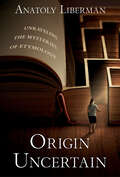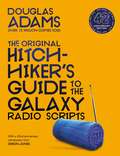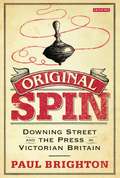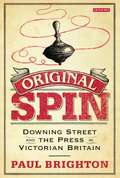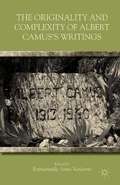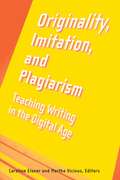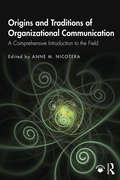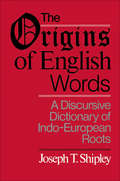- Table View
- List View
Origin Uncertain: Unraveling the Mysteries of Etymology
by Anatoly LibermanLost origins of words revealed. We like to recount that goodbye started out as "god be with you," that whiskey comes from the Gaelic for "water of life," or that avocado originated as the Aztec word for "testicle." But there are many words with origins unknown, disputed, or so buried in old journals that they may as well be lost to the general public. In Origin Uncertain: Unraveling the Mysteries of Etymology, eminent etymologist Anatoly Liberman draws on his professional expertise and etymological database to tell the stories of less understood words such as nerd, fake, ain't, hitchhike, trash, curmudgeon, and quiz, as well as puzzling idioms like kick the bucket and pay through the nose. By casting a net so broadly, the book addresses language history, language usage (including grammar), history (both ancient and modern), religion, superstitions, and material culture. Writing in the spirit of adventure through the annals of word origins, Liberman also shows how historical linguists construct etymologies, how to evaluate competing explanations, and how to pursue further research.
Origin Uncertain: Unraveling the Mysteries of Etymology
by Anatoly LibermanLost origins of words revealed. We like to recount that goodbye started out as "god be with you," that whiskey comes from the Gaelic for "water of life," or that avocado originated as the Aztec word for "testicle." But there are many words with origins unknown, disputed, or so buried in old journals that they may as well be lost to the general public. In Origin Uncertain: Unraveling the Mysteries of Etymology, eminent etymologist Anatoly Liberman draws on his professional expertise and etymological database to tell the stories of less understood words such as nerd, fake, ain't, hitchhike, trash, curmudgeon, and quiz, as well as puzzling idioms like kick the bucket and pay through the nose. By casting a net so broadly, the book addresses language history, language usage (including grammar), history (both ancient and modern), religion, superstitions, and material culture. Writing in the spirit of adventure through the annals of word origins, Liberman also shows how historical linguists construct etymologies, how to evaluate competing explanations, and how to pursue further research.
The Original Hitchhiker's Guide to the Galaxy Radio Scripts: The Original Radio Scripts
by Douglas AdamsMarch 1978 saw the first ever transmission of Douglas Adams' The Hitchhiker's Guide to the Galaxy on BBC Radio 4; the beginning of a cult phenomenon. March 2020 marks the 42nd anniversary of that first transmission – 42 being the answer, of course, to the Ultimate Question of Life, the Universe, and Everything. To mark the occasion, Pan Macmillan are bringing back into print The Hitchhiker's Guide to the Galaxy: The Original Radio Scripts with a brand-new introduction from Simon Jones.The collection also includes the previously 'lost' Hitchhiker script from the 25th anniversary edition, 'Sheila's Ear' and the original introductions by producer Geoffrey Perkins and Douglas Adams.This collection, which is a faithful reproduction of the text as it was first published in 1985, features all twelve original radio scripts – Hitchhiker as it was written and exactly as it was broadcast for the very first time. They include amendments and additions made during recordings and original notes on the writing and producing of the series by Douglas Adams and Geoffrey Perkins. For those who have always loved Douglas Adams, as well as for his new generation of fans, these scripts are essential reading and a must-have piece of Adams memorabilia.This special anniversary edition will sit alongside reissued eye-catching editions of the five individual Hitchhiker books coming in May 2020: The Hitchhiker's Guide to the Galaxy, The Restaurant at the End of the Universe, Life, the Universe and Everything, So Long, and Thanks for All the Fish and Mostly Harmless.
Original Spin: Downing Street and the Press in Victorian Britain
by Paul BrightonSecret lunches, off-the-record briefings, the leaking of confidential information and tightly-organised media launches - the well-known world of modern political spin. But is this really a new phenomenon or have politicians been manipulating the press for as long as newspapers have existed? In this important new book, Paul Brighton shows that spin is not something dreamed up by modern, media-savvy politicians. In fact, it was one of the best-kept political secrets of the eighteenth and nineteenth centuries. From Peel and Palmerston to Gladstone and Disraeli, Prime Ministers have all tried to manipulate the press to a greater or lesser extent. Brighton uncovers the covert contacts between Westminster and Fleet Street and reveals how the Victorian occupants of 10 Downing Street secretly conveyed their viewpoints via the newspapers. For the first time, "Original Spin" tells the whole, unvarnished, story.
Original Spin: Downing Street and the Press in Victorian Britain
by Paul BrightonSecret lunches, off-the-record briefings, the leaking of confidential information and tightly-organised media launches - the well-known world of modern political spin. But is this really a new phenomenon or have politicians been manipulating the press for as long as newspapers have existed? In this important new book, Paul Brighton shows that spin is not something dreamed up by modern, media-savvy politicians. In fact, it was one of the best-kept political secrets of the eighteenth and nineteenth centuries. From Peel and Palmerston to Gladstone and Disraeli, Prime Ministers have all tried to manipulate the press to a greater or lesser extent. Brighton uncovers the covert contacts between Westminster and Fleet Street and reveals how the Victorian occupants of 10 Downing Street secretly conveyed their viewpoints via the newspapers. For the first time, Original Spin tells the whole, unvarnished, story
The Originality and Complexity of Albert Camus’s Writings
by Emmanuelle Anne VanborreFifty years after Camus's untimely death, his work still has a tremendous impact on literature. From a twenty-first century vantage point, his work offer us coexisting ideas and principles by which we can read and understand the other and ourselves. Yet Camus seems to guide us without directing us strictly; his fictions do not offer clear-cut solutions or doctrines to follow. This complexity is what demands that the oeuvre be read, and reread. The wide-ranging articles in this volume shed light, concentrate on the original aspects of Camus' writings and explore how and why they are still relevant for us today.
Originality, Imitation, and Plagiarism: Teaching Writing in the Digital Age
by Martha Vicinus Caroline Eisner"At long last, a discussion of plagiarism that doesn't stop at 'Don't do it or else,' but does full justice to the intellectual interest of the topic!" ---Gerald Graff, author of Clueless in Academe and 2008 President, Modern Language Association This collection is a timely intervention in national debates about what constitutes original or plagiarized writing in the digital age. Somewhat ironically, the Internet makes it both easier to copy and easier to detect copying. The essays in this volume explore the complex issues of originality, imitation, and plagiarism, particularly as they concern students, scholars, professional writers, and readers, while also addressing a range of related issues, including copyright conventions and the ownership of original work, the appropriate dissemination of innovative ideas, and the authority and role of the writer/author. Throughout these essays, the contributors grapple with their desire to encourage and maintain free access to copyrighted material for noncommercial purposes while also respecting the reasonable desires of authors to maintain control over their own work. Both novice and experienced teachers of writing will learn from the contributors' practical suggestions about how to fashion unique assignments, teach about proper attribution, and increase students' involvement in their own writing. This is an anthology for anyone interested in how scholars and students can navigate the sea of intellectual information that characterizes the digital/information age. "Eisner and Vicinus have put together an impressive cast of contributors who cut through the war on plagiarism to examine key specificities that often get blurred by the rhetoric of slogans. It will be required reading not only for those concerned with plagiarism, but for the many more who think about what it means to be an author, a student, a scientist, or anyone who negotiates and renegotiates the meaning of originality and imitation in collaborative and information-intensive settings." ---Mario Biagioli, Professor of the History of Science, Harvard University, and coeditor of Scientific Authorship: Credit and Intellectual Property in Science "This is an important collection that addresses issues of great significance to teachers, to students, and to scholars across several disciplines. . . . These essays tackle their topics head-on in ways that are both accessible and provocative." ---Andrea Lunsford, Louise Hewlett Nixon Professor of English, Claude and Louise Rosenberg Jr. Fellow, and Director of the Program in Writing and Rhetoric at Stanford University and coauthor of Singular Texts/Plural Authors: Perspectives on Collaborative Writing digitalculturebooks is an imprint of the University of Michigan Press and the Scholarly Publishing Office of the University of Michigan Library dedicated to publishing innovative and accessible work exploring new media and their impact on society, culture, and scholarly communication. Visit the website at www.digitalculture.org.
Origins and Traditions of Organizational Communication: A Comprehensive Introduction to the Field
by Anne M. NicoteraOrigins and Traditions of Organizational Communication provides a sophisticated overview of the fundamentals of organizational communication as a field of study, examining the field’s foundations and providing an assessment of the field to date, explaining and demonstrating a communicational approach to the study of organization. It provides a set of literature reviews on focused topics written by experts in each area, and links organizational communication theory and research to practice. In reviewing foundational management theory, the book analyzes how early to mid-20th-century management theories shaped contemporary organizations, providing students both with background knowledge of these foundational theories and an understanding of their influence on our thinking and our organizational world. Written at an accessible level for early graduate students, yet still sophisticated enough for doctoral students, the book is ideal for students and teachers of organizational communication and communication history. Downloadable ancillary materials include chapter PowerPoints and a set of instructors' materials containing chapter abstracts, glossaries, discussion questions, annotated supplementary readings lists, and practitioners' corners.
Origins and Traditions of Organizational Communication: A Comprehensive Introduction to the Field
by Anne M. NicoteraOrigins and Traditions of Organizational Communication provides a sophisticated overview of the fundamentals of organizational communication as a field of study, examining the field’s foundations and providing an assessment of the field to date, explaining and demonstrating a communicational approach to the study of organization. It provides a set of literature reviews on focused topics written by experts in each area, and links organizational communication theory and research to practice. In reviewing foundational management theory, the book analyzes how early to mid-20th-century management theories shaped contemporary organizations, providing students both with background knowledge of these foundational theories and an understanding of their influence on our thinking and our organizational world. Written at an accessible level for early graduate students, yet still sophisticated enough for doctoral students, the book is ideal for students and teachers of organizational communication and communication history. Downloadable ancillary materials include chapter PowerPoints and a set of instructors' materials containing chapter abstracts, glossaries, discussion questions, annotated supplementary readings lists, and practitioners' corners.
The Origins of Cool in Postwar America
by Joel DinersteinCool. It was a new word and a new way to be, and in a single generation, it became the supreme compliment of American culture. The Origins of Cool in Postwar America uncovers the hidden history of this concept and its new set of codes that came to define a global attitude and style. As Joel Dinerstein reveals in this dynamic book, cool began as a stylish defiance of racism, a challenge to suppressed sexuality, a philosophy of individual rebellion, and a youthful search for social change. Through eye-opening portraits of iconic figures, Dinerstein illuminates the cultural connections and artistic innovations among Lester Young, Humphrey Bogart, Robert Mitchum, Billie Holiday, Frank Sinatra, Jack Kerouac, Albert Camus, Marlon Brando, and James Dean, among others. We eavesdrop on conversations among Jean-Paul Sartre, Simone de Beauvoir, and Miles Davis, and on a forgotten debate between Lorraine Hansberry and Norman Mailer over the "white Negro" and black cool. We come to understand how the cool worlds of Beat writers and Method actors emerged from the intersections of film noir, jazz, and existentialism. Out of this mix, Dinerstein sketches nuanced definitions of cool that unite concepts from African-American and Euro-American culture: the stylish stoicism of the ethical rebel loner; the relaxed intensity of the improvising jazz musician; the effortless, physical grace of the Method actor. To be cool is not to be hip and to be hot is definitely not to be cool. This is the first work to trace the history of cool during the Cold War by exploring the intersections of film noir, jazz, existential literature, Method acting, blues, and rock and roll. Dinerstein reveals that they came together to create something completely new—and that something is cool.
The Origins of Cool in Postwar America
by Joel DinersteinCool. It was a new word and a new way to be, and in a single generation, it became the supreme compliment of American culture. The Origins of Cool in Postwar America uncovers the hidden history of this concept and its new set of codes that came to define a global attitude and style. As Joel Dinerstein reveals in this dynamic book, cool began as a stylish defiance of racism, a challenge to suppressed sexuality, a philosophy of individual rebellion, and a youthful search for social change. Through eye-opening portraits of iconic figures, Dinerstein illuminates the cultural connections and artistic innovations among Lester Young, Humphrey Bogart, Robert Mitchum, Billie Holiday, Frank Sinatra, Jack Kerouac, Albert Camus, Marlon Brando, and James Dean, among others. We eavesdrop on conversations among Jean-Paul Sartre, Simone de Beauvoir, and Miles Davis, and on a forgotten debate between Lorraine Hansberry and Norman Mailer over the "white Negro" and black cool. We come to understand how the cool worlds of Beat writers and Method actors emerged from the intersections of film noir, jazz, and existentialism. Out of this mix, Dinerstein sketches nuanced definitions of cool that unite concepts from African-American and Euro-American culture: the stylish stoicism of the ethical rebel loner; the relaxed intensity of the improvising jazz musician; the effortless, physical grace of the Method actor. To be cool is not to be hip and to be hot is definitely not to be cool. This is the first work to trace the history of cool during the Cold War by exploring the intersections of film noir, jazz, existential literature, Method acting, blues, and rock and roll. Dinerstein reveals that they came together to create something completely new—and that something is cool.
The Origins of Cool in Postwar America
by Joel DinersteinCool. It was a new word and a new way to be, and in a single generation, it became the supreme compliment of American culture. The Origins of Cool in Postwar America uncovers the hidden history of this concept and its new set of codes that came to define a global attitude and style. As Joel Dinerstein reveals in this dynamic book, cool began as a stylish defiance of racism, a challenge to suppressed sexuality, a philosophy of individual rebellion, and a youthful search for social change. Through eye-opening portraits of iconic figures, Dinerstein illuminates the cultural connections and artistic innovations among Lester Young, Humphrey Bogart, Robert Mitchum, Billie Holiday, Frank Sinatra, Jack Kerouac, Albert Camus, Marlon Brando, and James Dean, among others. We eavesdrop on conversations among Jean-Paul Sartre, Simone de Beauvoir, and Miles Davis, and on a forgotten debate between Lorraine Hansberry and Norman Mailer over the "white Negro" and black cool. We come to understand how the cool worlds of Beat writers and Method actors emerged from the intersections of film noir, jazz, and existentialism. Out of this mix, Dinerstein sketches nuanced definitions of cool that unite concepts from African-American and Euro-American culture: the stylish stoicism of the ethical rebel loner; the relaxed intensity of the improvising jazz musician; the effortless, physical grace of the Method actor. To be cool is not to be hip and to be hot is definitely not to be cool. This is the first work to trace the history of cool during the Cold War by exploring the intersections of film noir, jazz, existential literature, Method acting, blues, and rock and roll. Dinerstein reveals that they came together to create something completely new—and that something is cool.
The Origins of Cool in Postwar America
by Joel DinersteinCool. It was a new word and a new way to be, and in a single generation, it became the supreme compliment of American culture. The Origins of Cool in Postwar America uncovers the hidden history of this concept and its new set of codes that came to define a global attitude and style. As Joel Dinerstein reveals in this dynamic book, cool began as a stylish defiance of racism, a challenge to suppressed sexuality, a philosophy of individual rebellion, and a youthful search for social change. Through eye-opening portraits of iconic figures, Dinerstein illuminates the cultural connections and artistic innovations among Lester Young, Humphrey Bogart, Robert Mitchum, Billie Holiday, Frank Sinatra, Jack Kerouac, Albert Camus, Marlon Brando, and James Dean, among others. We eavesdrop on conversations among Jean-Paul Sartre, Simone de Beauvoir, and Miles Davis, and on a forgotten debate between Lorraine Hansberry and Norman Mailer over the "white Negro" and black cool. We come to understand how the cool worlds of Beat writers and Method actors emerged from the intersections of film noir, jazz, and existentialism. Out of this mix, Dinerstein sketches nuanced definitions of cool that unite concepts from African-American and Euro-American culture: the stylish stoicism of the ethical rebel loner; the relaxed intensity of the improvising jazz musician; the effortless, physical grace of the Method actor. To be cool is not to be hip and to be hot is definitely not to be cool. This is the first work to trace the history of cool during the Cold War by exploring the intersections of film noir, jazz, existential literature, Method acting, blues, and rock and roll. Dinerstein reveals that they came together to create something completely new—and that something is cool.
The Origins of Cool in Postwar America
by Joel DinersteinCool. It was a new word and a new way to be, and in a single generation, it became the supreme compliment of American culture. The Origins of Cool in Postwar America uncovers the hidden history of this concept and its new set of codes that came to define a global attitude and style. As Joel Dinerstein reveals in this dynamic book, cool began as a stylish defiance of racism, a challenge to suppressed sexuality, a philosophy of individual rebellion, and a youthful search for social change. Through eye-opening portraits of iconic figures, Dinerstein illuminates the cultural connections and artistic innovations among Lester Young, Humphrey Bogart, Robert Mitchum, Billie Holiday, Frank Sinatra, Jack Kerouac, Albert Camus, Marlon Brando, and James Dean, among others. We eavesdrop on conversations among Jean-Paul Sartre, Simone de Beauvoir, and Miles Davis, and on a forgotten debate between Lorraine Hansberry and Norman Mailer over the "white Negro" and black cool. We come to understand how the cool worlds of Beat writers and Method actors emerged from the intersections of film noir, jazz, and existentialism. Out of this mix, Dinerstein sketches nuanced definitions of cool that unite concepts from African-American and Euro-American culture: the stylish stoicism of the ethical rebel loner; the relaxed intensity of the improvising jazz musician; the effortless, physical grace of the Method actor. To be cool is not to be hip and to be hot is definitely not to be cool. This is the first work to trace the history of cool during the Cold War by exploring the intersections of film noir, jazz, existential literature, Method acting, blues, and rock and roll. Dinerstein reveals that they came together to create something completely new—and that something is cool.
The Origins of Cool in Postwar America
by Joel DinersteinCool. It was a new word and a new way to be, and in a single generation, it became the supreme compliment of American culture. The Origins of Cool in Postwar America uncovers the hidden history of this concept and its new set of codes that came to define a global attitude and style. As Joel Dinerstein reveals in this dynamic book, cool began as a stylish defiance of racism, a challenge to suppressed sexuality, a philosophy of individual rebellion, and a youthful search for social change. Through eye-opening portraits of iconic figures, Dinerstein illuminates the cultural connections and artistic innovations among Lester Young, Humphrey Bogart, Robert Mitchum, Billie Holiday, Frank Sinatra, Jack Kerouac, Albert Camus, Marlon Brando, and James Dean, among others. We eavesdrop on conversations among Jean-Paul Sartre, Simone de Beauvoir, and Miles Davis, and on a forgotten debate between Lorraine Hansberry and Norman Mailer over the "white Negro" and black cool. We come to understand how the cool worlds of Beat writers and Method actors emerged from the intersections of film noir, jazz, and existentialism. Out of this mix, Dinerstein sketches nuanced definitions of cool that unite concepts from African-American and Euro-American culture: the stylish stoicism of the ethical rebel loner; the relaxed intensity of the improvising jazz musician; the effortless, physical grace of the Method actor. To be cool is not to be hip and to be hot is definitely not to be cool. This is the first work to trace the history of cool during the Cold War by exploring the intersections of film noir, jazz, existential literature, Method acting, blues, and rock and roll. Dinerstein reveals that they came together to create something completely new—and that something is cool.
The Origins of Cool in Postwar America
by Joel DinersteinCool. It was a new word and a new way to be, and in a single generation, it became the supreme compliment of American culture. The Origins of Cool in Postwar America uncovers the hidden history of this concept and its new set of codes that came to define a global attitude and style. As Joel Dinerstein reveals in this dynamic book, cool began as a stylish defiance of racism, a challenge to suppressed sexuality, a philosophy of individual rebellion, and a youthful search for social change. Through eye-opening portraits of iconic figures, Dinerstein illuminates the cultural connections and artistic innovations among Lester Young, Humphrey Bogart, Robert Mitchum, Billie Holiday, Frank Sinatra, Jack Kerouac, Albert Camus, Marlon Brando, and James Dean, among others. We eavesdrop on conversations among Jean-Paul Sartre, Simone de Beauvoir, and Miles Davis, and on a forgotten debate between Lorraine Hansberry and Norman Mailer over the "white Negro" and black cool. We come to understand how the cool worlds of Beat writers and Method actors emerged from the intersections of film noir, jazz, and existentialism. Out of this mix, Dinerstein sketches nuanced definitions of cool that unite concepts from African-American and Euro-American culture: the stylish stoicism of the ethical rebel loner; the relaxed intensity of the improvising jazz musician; the effortless, physical grace of the Method actor. To be cool is not to be hip and to be hot is definitely not to be cool. This is the first work to trace the history of cool during the Cold War by exploring the intersections of film noir, jazz, existential literature, Method acting, blues, and rock and roll. Dinerstein reveals that they came together to create something completely new—and that something is cool.
The Origins of Criticism: Literary Culture and Poetic Theory in Classical Greece
by Andrew FordBy "literary criticism" we usually mean a self-conscious act involving the technical and aesthetic appraisal, by individuals, of autonomous works of art. Aristotle and Plato come to mind. The word "social" does not. Yet, as this book shows, it should--if, that is, we wish to understand where literary criticism as we think of it today came from. Andrew Ford offers a new understanding of the development of criticism, demonstrating that its roots stretch back long before the sophists to public commentary on the performance of songs and poems in the preliterary era of ancient Greece. He pinpoints when and how, later in the Greek tradition than is usually assumed, poetry was studied as a discipline with its own principles and methods. The Origins of Criticism complements the usual, history-of-ideas approach to the topic precisely by treating criticism as a social as well as a theoretical activity. With unprecedented and penetrating detail, Ford considers varying scholarly interpretations of the key texts discussed. Examining Greek discussions of poetry from the late sixth century B.C. through the rise of poetics in the late fourth, he asks when we first can recognize anything like the modern notions of literature as imaginative writing and of literary criticism as a special knowledge of such writing. Serving as a monumental preface to Aristotle's Poetics, this book allows readers to discern the emergence, within the manifold activities that might be called criticism, of the historically specific discourse on poetry that has shaped subsequent Western approaches to literature.
The Origins of Criticism: Literary Culture and Poetic Theory in Classical Greece
by Andrew FordBy "literary criticism" we usually mean a self-conscious act involving the technical and aesthetic appraisal, by individuals, of autonomous works of art. Aristotle and Plato come to mind. The word "social" does not. Yet, as this book shows, it should--if, that is, we wish to understand where literary criticism as we think of it today came from. Andrew Ford offers a new understanding of the development of criticism, demonstrating that its roots stretch back long before the sophists to public commentary on the performance of songs and poems in the preliterary era of ancient Greece. He pinpoints when and how, later in the Greek tradition than is usually assumed, poetry was studied as a discipline with its own principles and methods. The Origins of Criticism complements the usual, history-of-ideas approach to the topic precisely by treating criticism as a social as well as a theoretical activity. With unprecedented and penetrating detail, Ford considers varying scholarly interpretations of the key texts discussed. Examining Greek discussions of poetry from the late sixth century B.C. through the rise of poetics in the late fourth, he asks when we first can recognize anything like the modern notions of literature as imaginative writing and of literary criticism as a special knowledge of such writing. Serving as a monumental preface to Aristotle's Poetics, this book allows readers to discern the emergence, within the manifold activities that might be called criticism, of the historically specific discourse on poetry that has shaped subsequent Western approaches to literature.
The Origins of Criticism: Literary Culture and Poetic Theory in Classical Greece
by Andrew FordBy "literary criticism" we usually mean a self-conscious act involving the technical and aesthetic appraisal, by individuals, of autonomous works of art. Aristotle and Plato come to mind. The word "social" does not. Yet, as this book shows, it should--if, that is, we wish to understand where literary criticism as we think of it today came from. Andrew Ford offers a new understanding of the development of criticism, demonstrating that its roots stretch back long before the sophists to public commentary on the performance of songs and poems in the preliterary era of ancient Greece. He pinpoints when and how, later in the Greek tradition than is usually assumed, poetry was studied as a discipline with its own principles and methods. The Origins of Criticism complements the usual, history-of-ideas approach to the topic precisely by treating criticism as a social as well as a theoretical activity. With unprecedented and penetrating detail, Ford considers varying scholarly interpretations of the key texts discussed. Examining Greek discussions of poetry from the late sixth century B.C. through the rise of poetics in the late fourth, he asks when we first can recognize anything like the modern notions of literature as imaginative writing and of literary criticism as a special knowledge of such writing. Serving as a monumental preface to Aristotle's Poetics, this book allows readers to discern the emergence, within the manifold activities that might be called criticism, of the historically specific discourse on poetry that has shaped subsequent Western approaches to literature.
The Origins of Dislike
by Amit Chaudhuri'Strategic thinking for a writer articulates itself as dislike and as allegiance.' In this wonderfully rich and diverse collection of essays, Amit Chaudhuri explores the way in which writers understand and promote their own work in antithesis to writers and movements that have gone before. Chaudhuri's criticism disproves and questions several assumptions—that a serious and original artist cannot think critically in a way that matters; that criticism can't be imaginative, and creative work contain radical argumentation; that a writer reflecting on their own position and practice cannot be more than a testimony of their work, but open up how we think of literary history and reading. Illuminating new ways of thinking about Western and non-Western traditions, prejudices, and preconceptions, Chaudhuri shows us again that he takes nothing as a given: literary tradition, the prevalent definitions of writing and culture; and the way the market determines the way culture and language express themselves. He asks us to look again at what we mean by the modern, and how it might be possible to think of the literary today.
The Origins of Dislike
by Amit Chaudhuri'Strategic thinking for a writer articulates itself as dislike and as allegiance.' In this wonderfully rich and diverse collection of essays, Amit Chaudhuri explores the way in which writers understand and promote their own work in antithesis to writers and movements that have gone before. Chaudhuri's criticism disproves and questions several assumptions—that a serious and original artist cannot think critically in a way that matters; that criticism can't be imaginative, and creative work contain radical argumentation; that a writer reflecting on their own position and practice cannot be more than a testimony of their work, but open up how we think of literary history and reading. Illuminating new ways of thinking about Western and non-Western traditions, prejudices, and preconceptions, Chaudhuri shows us again that he takes nothing as a given: literary tradition, the prevalent definitions of writing and culture; and the way the market determines the way culture and language express themselves. He asks us to look again at what we mean by the modern, and how it might be possible to think of the literary today.
The Origins of English Nonsense
by Noel MalcolmA major rediscovery and reevaluation of a lost strand of English literature from one of today’s most brilliant scholars.
The Origins of English Words: A Discursive Dictionary of Indo-European Roots
by Joseph Twadell ShipleyThere are no direct records of the original Indo-European speech. By comparing the vocabularies of its various descendants, however, it is possible to reconstruct the basic Indo-European roots with considerable confidence. In The Origins of English Words, Shipley catalogues these proposed roots and follows the often devious, always fascinating, process by which some of their offshoots have grown.Anecdotal, eclectic, and always enthusiastic, The Origins of English Words is a diverting expedition beyond linguistics into literature, history, folklore, anthropology, philosophy, and science.
The Origins of Grammar: An Anthropological Perspective
by Martin EdwardesQuintessential work on the nature and origins of language grammar, and its role in language and our own evolution as humans.
The Origins of History (Routledge Library Editions: Historiography)
by Herbert ButterfieldA distillation of the thought and research to which Herbert Butterfield devoted the last twenty years of his life to, this book, originally published in 1981, traces how differently people understood the relevance of their past and its connection with their religion. It examines ancient Egypt and Mesopotamia; the political perceptiveness of the Hittites; the Jewish sense of God in history, of promise and fulfilment; the classical achievement of scientific history; and the unique Chinese tradition of historical writing. The author explains the problems of the early Christians in relating their traditions of Jesus to their life and faith and the emergence, when Christianity became the religion of the Roman Empire, of a new historical understanding. The book then charts the gradual growth of a sceptical approach to recorded authority in Islam and Western Europe, the reconstruction of the past by deductive analysis of the surviving evidence and the secularisation of the eighteenth century.

